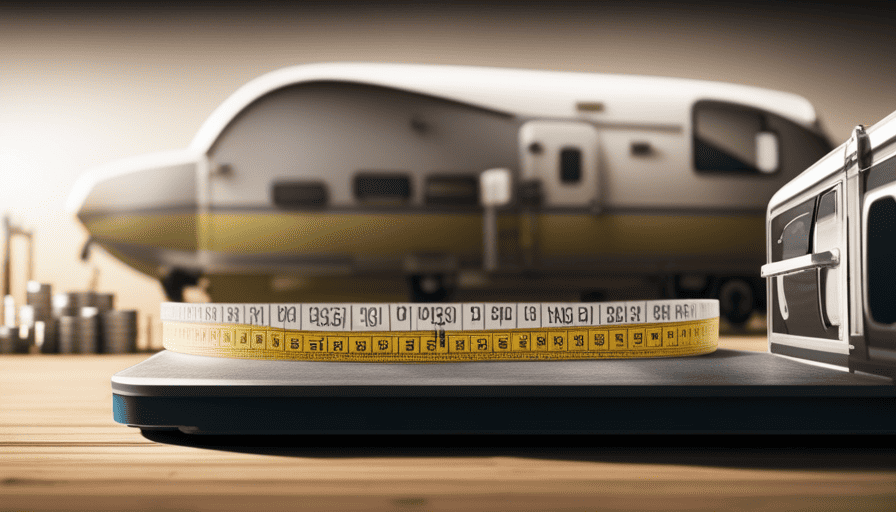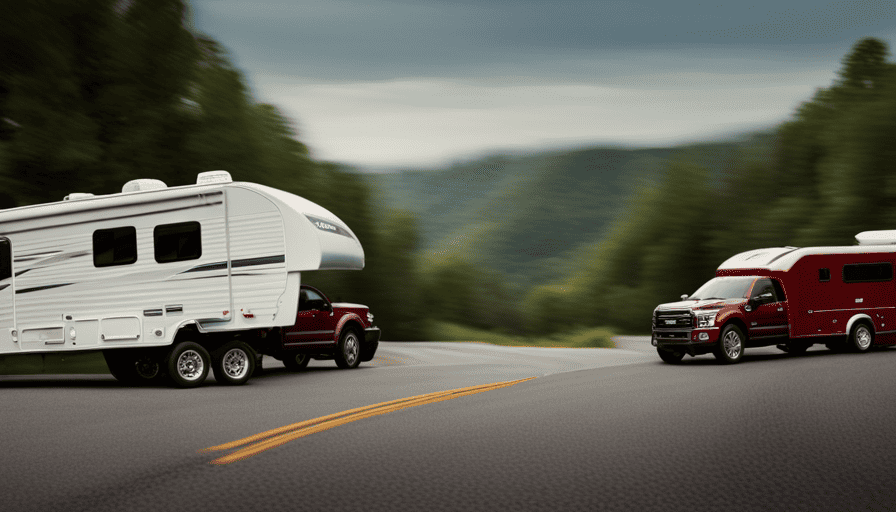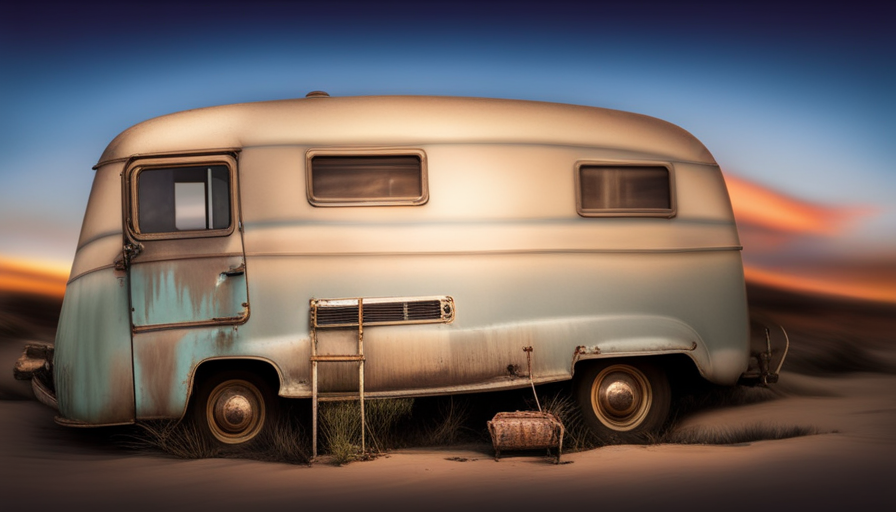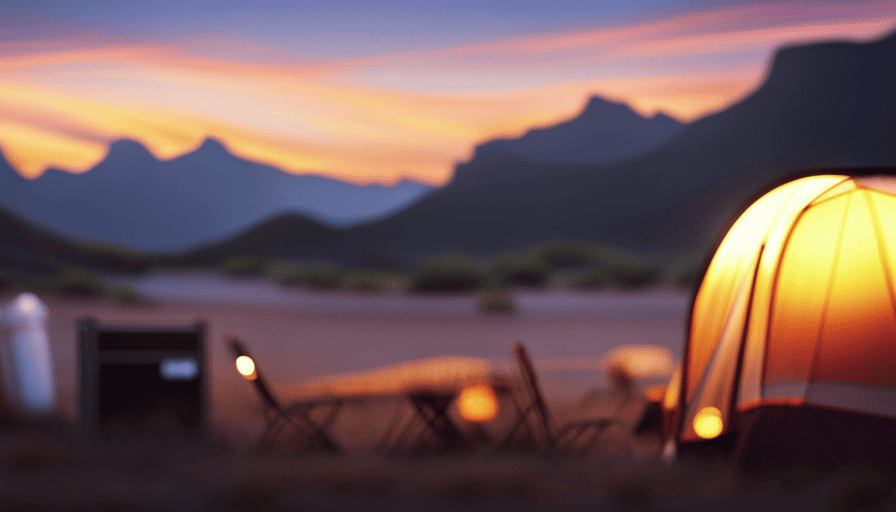You may be wondering, “Why is it important to know the weight of camper trailers?”
Well, let me tell you, understanding the weight of your camper trailer is crucial for a variety of reasons.
Some may argue that the weight of a camper trailer is irrelevant, as long as it can be towed by a vehicle. However, this couldn’t be further from the truth.
Knowing the weight of your camper trailer allows you to determine if your vehicle can safely tow it, prevents overloading, and ensures optimal weight distribution for a smoother and safer towing experience.
In this article, we will delve into the factors that affect camper trailer weight, explore the different types of camper trailers and their average weights, discuss how to weigh your camper trailer, and provide valuable information on legal and safety considerations.
So, let’s get started and discover the importance of understanding how much camper trailers weigh.
Key Takeaways
- Understanding the weight of a camper trailer is crucial for safe towing and preventing overloading.
- Different types of camper trailers have varying weight ranges and amenities.
- Proper weight distribution and balance are important for stability and preventing accidents.
- Regular maintenance, including tire inflation and inspection, is necessary for safe towing.
Factors Affecting Camper Trailer Weight
If you’re curious about the factors that influence the weight of camper trailers, you’ll be amazed at how much these little details can make a big difference.
One important factor to consider is weight distribution. The way the weight is distributed within the trailer affects its overall weight. Camper trailers are designed to have a balanced weight distribution to ensure stability while towing. Uneven weight distribution can lead to swaying and potentially dangerous situations on the road.
Another factor to consider is the towing capacity of the vehicle. Each vehicle has a specific towing capacity, which is the maximum weight it can safely tow. It’s crucial to know the towing capacity of your vehicle before choosing a camper trailer. Exceeding the towing capacity can put excessive strain on the engine, transmission, and brakes, leading to potential damage or accidents.
Understanding the Gross Vehicle Weight Rating (GVWR) is essential when it comes to camper trailer weight. The GVWR is the maximum weight that a vehicle can safely carry, including its own weight, passengers, cargo, and the tongue weight of the trailer. This rating helps ensure the overall safety and performance of the vehicle.
By considering weight distribution and towing capacity, you can make informed decisions about the weight of your camper trailer.
Understanding Gross Vehicle Weight Rating (GVWR)
The weight of camper trailers can be determined by understanding their Gross Vehicle Weight Rating (GVWR). GVWR refers to the maximum weight that a vehicle is designed to safely carry, including its own weight, passengers, cargo, and fluids. It is an important factor to consider when choosing a camper trailer as it ensures the safety and longevity of the vehicle.
One key aspect of GVWR is the importance of proper weight distribution. This means that the weight of the trailer should be evenly distributed to prevent excessive strain on certain parts of the vehicle. Uneven weight distribution can lead to poor handling, increased tire wear, and potential structural damage.
Understanding payload capacity is also crucial when it comes to camper trailer weight. Payload capacity refers to the maximum weight of passengers, cargo, and fluids that the trailer can safely carry. Exceeding the payload capacity can put unnecessary stress on the vehicle and compromise its safety.
Understanding the GVWR of camper trailers is essential for ensuring safe and efficient towing. It helps determine the proper weight distribution and payload capacity, which are vital for maintaining the longevity and performance of the trailer.
Moving on to the subsequent section, let’s explore the different types of camper trailers and their average weights.
Different Types of Camper Trailers and Their Average Weights
When it comes to camper trailers, there are several different types to consider. Pop-Up Campers are lightweight and easy to tow, making them a popular choice for those who want a more budget-friendly option.
Travel Trailers are larger and offer more amenities, making them ideal for longer trips or full-time living.
Fifth Wheel Trailers are known for their stability and spaciousness, and they are often towed by larger trucks.
Finally, Toy Haulers are perfect for those who want to bring along their recreational vehicles, as they have a garage space in the back.
Each type of camper trailer has its own average weight, so it’s important to consider this when choosing the right one for your needs.
Pop-Up Campers
Pack up your worries and witness the weight of wonder with pop-up campers. These versatile camping trailers are known for their unique features and lightweight design, making them a popular choice for outdoor enthusiasts.
Pop-up campers, also known as tent trailers, are constructed with collapsible walls and roofs that can be easily expanded when in use. This design allows for a compact and lightweight camper option that is perfect for towing behind smaller vehicles.
Despite their lightweight construction, pop-up campers offer a range of amenities, such as sleeping quarters, kitchenettes, and even bathrooms.
Now, let’s transition into the next section about travel trailers, where we’ll explore their larger size and increased amenities.
Travel Trailers
Get ready for a whole new level of adventure with travel trailers – these spacious and feature-packed campers are sure to elevate your outdoor experience. When it comes to travel trailer maintenance, it’s important to regularly inspect and service your camper to ensure everything is in working order. This includes checking the tires, brakes, electrical systems, and plumbing. Additionally, selecting the right tow vehicle is crucial for a safe and smooth journey. Consider factors such as the trailer’s weight, the tow vehicle’s towing capacity, and the hitch system. To give you an idea of the range of weights for travel trailers, take a look at the table below:
| Trailer Model | Weight Range (lbs) |
|---|---|
| Small | 1,500 – 3,500 |
| Mid-size | 3,500 – 6,000 |
| Large | 6,000 – 10,000 |
| Luxury | 10,000+ |
With these maintenance tips and weight considerations, you’ll be well-prepared for your travel trailer adventures. Now, let’s move on to the next exciting topic – fifth wheel trailers.
Fifth Wheel Trailers
With their unique design and spacious interiors, fifth wheel trailers offer a luxurious and comfortable camping experience like no other. These trailers are specifically designed to be towed by a pickup truck using a fifth wheel hitch, which provides greater stability and maneuverability on the road.
Here are three advantages of fifth wheel trailers:
-
Increased living space: Fifth wheel trailers have an overhang that extends over the truck bed, allowing for a larger living area compared to other types of trailers.
-
Better towing experience: The placement of the hitch in the truck bed distributes the weight more evenly, resulting in improved towing stability and reduced swaying.
-
Enhanced maneuverability: The pivoting point of the fifth wheel hitch allows for tighter turns, making it easier to navigate through narrow roads or campsite spaces.
Now, let’s move on to the next type of camper trailers: toy haulers.
Toy Haulers
When it comes to camper trailers, there are a variety of options to choose from. In my previous discussion, we explored fifth wheel trailers and their unique features. Now, let’s delve into another popular type of camper trailer: toy haulers.
Toy haulers are specifically designed to transport recreational vehicles, such as ATVs, motorcycles, or even small boats. These trailers have a spacious rear garage area that can be transformed into a living space or sleeping quarters once the toys are unloaded. This makes them an excellent choice for outdoor enthusiasts who want to bring their toys along on their camping adventures.
One of the key benefits of toy haulers is their versatility. They provide ample storage space for your gear and allow you to easily transport your recreational vehicles without the need for an additional trailer. Additionally, many toy haulers come equipped with modern amenities, including kitchens, bathrooms, and entertainment systems, ensuring a comfortable and enjoyable camping experience.
Now that we’ve explored the features and benefits of toy haulers, let’s move on to the next section where we’ll discuss how to weigh your camper trailer.
How to Weigh Your Camper Trailer
To determine the weight of your camper trailer, simply attach a scale to the hitch and effortlessly obtain the crucial information you seek. Understanding the weight of your camper trailer is essential for a successful camping experience. Here’s how you can calculate it:
-
Attach a scale: Find a sturdy scale that can handle the weight of your trailer. Attach it to the hitch of your camper trailer.
-
Level your trailer: Ensure that your trailer is level before weighing it. This will provide accurate results.
-
Disconnect from the tow vehicle: Detach your camper trailer from the tow vehicle and let it rest on the scale.
-
Read the weight: Once your trailer is stable on the scale, read the weight displayed on the scale. This will give you the weight of your camper trailer.
Knowing the weight of your camper trailer is important for various reasons, including determining the right tow vehicle and calculating the amount of cargo you can safely carry. Additionally, understanding the weight distribution and balance of your camper trailer is crucial for safe towing.
So, now that you know how to weigh your trailer, let’s delve into the importance of weight distribution and balance.
Importance of Weight Distribution and Balance
Proper weight distribution and balance in your camper trailer is crucial for safe and stable towing, ensuring a smooth and enjoyable camping experience. The importance of weight distribution cannot be overstated when it comes to camper trailers. Uneven weight distribution can lead to a range of problems, such as swaying, instability, and even accidents on the road.
To avoid these issues, it’s essential to understand weight management strategies. One of the key weight management strategies is to ensure that the weight is evenly distributed from front to back and side to side. This can be achieved by placing heavier items towards the center of the trailer and balancing the weight between the left and right sides.
Additionally, it’s important to keep an eye on the overall weight of your camper trailer. Exceeding the maximum weight limit can put unnecessary strain on your vehicle and compromise its safety.
By maintaining proper weight distribution and balance, you can enjoy a smoother and safer towing experience.
In the next section, we’ll discuss tips for managing and reducing camper trailer weight, which will further help in achieving optimal weight distribution and balance.
Tips for Managing and Reducing Camper Trailer Weight
One effective way to manage and decrease the weight of your camper trailer is by implementing these helpful tips.
Managing weight distribution is crucial for maintaining balance and stability while towing. Start by distributing the weight evenly across the trailer, placing heavier items towards the front and center. This helps to prevent swaying and ensures better control during transportation.
Additionally, consider removing any unnecessary items that add unnecessary weight. Evaluate each item’s importance and usefulness, and only pack what’s necessary for your trip.
Another important factor to consider is the towing capacity of your vehicle. Different vehicles have different towing capacities, so it’s essential to know your vehicle’s limits. Exceeding the towing capacity can strain your vehicle’s engine and transmission, potentially causing damage. Before embarking on your trip, check your vehicle’s owner manual to determine its towing capacity.
By managing your camper trailer’s weight distribution and being aware of your vehicle’s towing capacity, you can ensure a safer and more enjoyable camping experience.
In the next section, we’ll discuss the importance of knowing the towing capacity of different vehicles, providing valuable insights for selecting the right vehicle for your camper trailer.
Towing Capacity of Different Vehicles
Make sure you know the towing capacity of your vehicle before hitting the road with your camper trailer, so you can confidently choose the right vehicle and avoid any potential damage or disappointment along the way. Understanding the towing capacity of different vehicles is essential for a safe and enjoyable towing experience.
Here are three important factors to consider when it comes to towing capacity and trailer hitch compatibility:
-
Manufacturer’s Specifications: Check your vehicle’s owner’s manual or contact the manufacturer to find out the maximum towing capacity. This information is crucial as exceeding the recommended towing capacity can strain your vehicle’s engine, transmission, and brakes.
-
Trailer Hitch Class: Different vehicles have different types of trailer hitches, classified by weight-carrying capacity. Ensure that your trailer hitch is compatible with your camper trailer’s weight to ensure a secure connection.
-
Gross Vehicle Weight Rating (GVWR): This is the maximum weight that your vehicle can safely carry, including passengers, cargo, and the tongue weight of the camper trailer. Exceeding the GVWR can lead to instability and potential safety hazards.
Understanding the towing capacity and trailer hitch compatibility of your vehicle is vital for a safe and successful towing experience. Now, let’s delve into the next section about legal and safety considerations when towing a camper trailer.
Legal and Safety Considerations
When it comes to towing a camper trailer, there are important legal and safety considerations that need to be taken into account.
It is crucial to comply with both state and federal regulations to ensure that you’re operating within the law.
Additionally, ensuring safe and stable towing is essential for the well-being of both yourself and others on the road.
Complying with State and Federal Regulations
To comply with state and federal regulations, you’ll need to ensure that your camper trailer meets weight restrictions, which can vary depending on the jurisdiction.
Did you know that the average weight of a camper trailer is around 5,200 pounds? Compliance regulations regarding camper trailer weights are put in place to ensure safety on the roads.
It is important to check the specific weight restrictions for the state or federal jurisdiction you will be traveling in. Exceeding these weight limits can result in fines and penalties. Additionally, overweight trailers can pose a risk to other drivers and may cause damage to your vehicle.
Ensuring safe and stable towing requires not only adhering to weight restrictions but also properly distributing the weight within the trailer and using appropriate towing equipment.
Ensuring Safe and Stable Towing
You can ensure a safe and stable towing experience by carefully distributing the weight within your camper trailer and using the right towing equipment. Proper weight distribution is essential for towing safety as it helps maintain control and stability on the road. When loading your camper trailer, make sure to distribute the weight evenly from front to back and side to side. This can be achieved by placing heavier items over the axle and avoiding overloading one side. Additionally, using a weight distribution hitch can help evenly distribute the weight between your vehicle and the trailer, reducing the strain on your vehicle’s rear axle. By following these guidelines, you can ensure a safer and more stable towing experience. Moving on to maintenance and upkeep for camper trailer weight, it is important to regularly inspect your trailer’s weight distribution system and ensure all components are in good working condition.
Maintenance and Upkeep for Camper Trailer Weight
When it comes to maintaining and keeping up with the weight of a camper trailer, regular inspections and maintenance are key. It is important to regularly check for any signs of wear and tear, such as loose bolts or damaged parts, and address them promptly to prevent further damage or accidents on the road.
Additionally, proper tire inflation and maintenance is crucial to ensure safe and efficient towing. Underinflated or worn-out tires can affect the overall weight distribution and stability of the trailer.
Regular Inspections and Maintenance
Regular inspections and maintenance help ensure that your camper trailer stays in optimal condition, allowing you to enjoy worry-free travels. By conducting regular inspections, you can identify any issues or potential problems before they become major concerns. This includes checking for any signs of wear and tear on the trailer’s exterior and interior, as well as inspecting the weight distribution to ensure it is properly balanced. Additionally, regular maintenance tasks such as cleaning, lubricating hinges and locks, and checking the electrical system can help prolong the lifespan of your camper trailer. If you find that your trailer is exceeding its weight capacity, you may need to consider reducing weight by removing unnecessary items or upgrading to lighter alternatives. By taking these steps, you can keep your camper trailer in top shape and ready for your next adventure. Speaking of maintenance, proper tire inflation and maintenance are also crucial for a safe and smooth journey.
Proper Tire Inflation and Maintenance
Maintaining the proper inflation and care of your camper trailer’s tires is essential for a safe and enjoyable journey. To ensure your tires are in good condition, it’s important to regularly check the tire pressure and tread depth.
Proper tire pressure is crucial as underinflation can lead to increased tire wear and reduced fuel efficiency, while overinflation can cause a harsher ride and potential blowouts. Use a tire pressure gauge to measure the pressure and adjust it accordingly based on the manufacturer’s recommendations.
Additionally, regularly inspect the tread depth using a tread depth gauge. This will help you determine if your tires have enough grip for safe driving.
By properly maintaining your camper trailer’s tires, you can have peace of mind knowing that you’re prepared for the road ahead.
Moving on to resources for researching camper trailer weight…
Resources for Researching Camper Trailer Weight
While researching camper trailer weight, it’s helpful to utilize resources that provide accurate and detailed information. When looking for this information, there are several resources available that can assist in finding the weight of different camper trailer models and comparing their features. These resources can help you make an informed decision when it comes to choosing the right camper trailer for your needs.
One useful resource for researching camper trailer weight is manufacturer websites. Many camper trailer manufacturers provide detailed specifications for each of their models, including the weight of the trailer. These websites often have search filters that allow you to narrow down your options based on weight and other features, making it easier to compare different models.
Another valuable resource is online forums and discussion boards dedicated to camping and RVing. These forums often have threads where users discuss and compare different camper trailer models. You can ask questions and get recommendations from experienced campers who have firsthand knowledge of the weight and features of various trailers.
Lastly, there are online marketplaces for camper trailers that provide detailed listings with specifications and weight information. These marketplaces allow you to search for camper trailers based on weight and compare different options side by side.
By utilizing these resources, you can gather accurate and detailed information about camper trailer weight, allowing you to make an informed decision when comparing different models and features.
Frequently Asked Questions
Are camper trailers allowed on all types of roads and highways?
Yes, camper trailers are allowed on all types of roads and highways, but there are certain weight limits and legal requirements that must be followed.
The weight limits for camper trailers vary depending on the specific road or highway regulations.
It’s important to know the weight limits and ensure that your camper trailer is within the legal requirements to avoid any potential fines or issues while traveling.
How often should I weigh my camper trailer?
Weight distribution of a camper trailer is crucial for safe and efficient towing. To ensure optimal performance, it’s recommended to weigh your camper trailer at least once a year or whenever there are significant changes in its load or configuration.
Regular weighing helps maintain proper weight distribution, preventing issues such as swaying or instability on the road. It also ensures that you’re within the legal weight limits, promoting road safety for yourself and other drivers.
What are some common mistakes people make when trying to reduce camper trailer weight?
When it comes to reducing camper trailer weight, there are some common misconceptions that people often fall prey to. One mistake is assuming that removing large items alone will make a significant difference. In reality, it’s important to assess the weight of every single item and prioritize what is essential.
Additionally, using lightweight materials, optimizing storage space, and investing in efficient equipment are all effective tips for reducing weight effectively.
Can I tow a camper trailer with a small SUV?
Yes, it’s possible to tow a camper trailer with a small SUV. However, it’s important to consider the SUV’s towing capacity and safety considerations. Check your SUV’s owner manual or consult the manufacturer to determine its maximum towing capacity. It’s crucial not to exceed this limit as it can compromise safety and put unnecessary strain on your vehicle.
Additionally, make sure you have the proper towing equipment and that your SUV is equipped with the necessary features for safe towing.
Are there any regulations regarding the weight distribution and balance of a camper trailer?
Weight distribution requirements and camper trailer balance regulations are essential for safe towing. It’s fascinating to note that 60% of the trailer’s weight should be towards the front, while the remaining 40% distributed towards the rear. This ensures stability and prevents swaying during travel.
Additionally, regulations state that the trailer’s weight should be evenly distributed across both sides to maintain balance. Adhering to these guidelines is crucial for a smooth and secure towing experience.
Conclusion
After delving into the depths of camper trailer weight, I must say, it’s a weighty matter! Factors like size, construction materials, and amenities all play a part. But fear not, dear reader, for understanding your Gross Vehicle Weight Rating (GVWR) is key.
Different types of trailers have different average weights, so choose wisely. Weighing your trailer and ensuring proper weight distribution is crucial for safe travels. And don’t forget about your vehicle’s towing capacity!
Remember, knowledge is power when it comes to legal and safety considerations. So, keep your trailer weight in mind and happy trails ahead!










